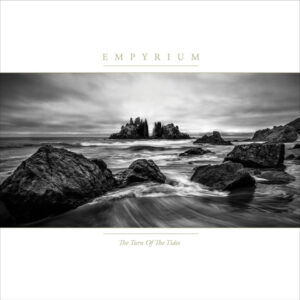 Label: Prophecy Productions
Label: Prophecy Productions
Release date: July 18th, 2014
Empyrium’s “The Turn of the Tides” is less an album in the conventional sense and more a poetic meditation on loss, transience, and the spiritual resonance of nature. Across its seven tracks, the band crafts a soundscape that blends neofolk, neoclassical darkwave, and romantic doom into something elegiac and contemplative. These are not just songs, they are seasonal elegies, with each movement echoing through fog-bound landscapes and frozen shores, where memory, decay, and longing meet in quiet reverence.
Founded in 1994 by Markus Stock (a.k.a. Ulf Theodor Schwadorf), Empyrium began as a symphonic doom metal project before transitioning into a more acoustic and neofolk-oriented direction with albums like “Where at Night the Wood Grouse Plays” (1999) and “Weiland” (2002). After a long period of silence and presumed disbandment, the band returned in 2010 with the “Whom the Moon a Night Song Sings” compilation. More significantly, they followed this with “The Turn of the Tides” in 2014, which marked their first full-length album in over a decade. This record marks a subtle reintegration of their earlier metal elements with their matured neoclassical and dark folk sensibilities, forming a seamless, introspective whole that feels both like a culmination and a rebirth.
From the opening notes of “Saviour”, the listener is set adrift into a void both metaphysical and emotional. The lyrics speak of drifting voicelessly through darkness, with the soul “astrayed” in autumn’s maze. This suggests not merely a personal loss but a spiritual disintegration. And yet, even within this desolation, Empyrium allows a “spark of grace” to flicker through, hinting that beauty might still be born from pain. This subtle tension between despair and the faintest hope becomes the album’s central emotional current.
“Dead Winter Ways” follows like a stiller, colder exhale. Winter is personified, not as a season but as a ghost, breathing over frozen rivers and shrouded moors. The world is inert, and yet deeply alive with symbolic weight. The call for rescue from this wintry desolation becomes an existential yearning, a plea not just for shelter from the cold, but from the spiritual barrenness that such stillness evokes. Nature here is both the mourner and the priest.
“In the Gutter of This Spring” turns the traditional idea of spring as a time of renewal on its head. Instead of rebirth, the season appears corrupted. Rains fall on “foul soil” and snow melts into “waters made of woe”. The past bleeds into the present and regeneration is tainted while hope remains suspended. Spring becomes a metaphor for emotional paralysis, a time when memory and grief pool together in the runoff of what once was. Renewal is not denied, but it is made hauntingly unreachable.
“The Days Before the Fall” stands as a centerpiece of bittersweet nostalgia. It evokes an Edenic past where nature was in harmony with the self. The lyrics speak of “airy sweetness” and “lazing winds”, painting a scene of serene, unspoiled beauty. But this serenity is distant, “asleep”, and autumn’s grey pallor has overtaken it. There is no lament in the loss, only quiet remembrance. It’s a song that does not rage against time, but gently mourns its passing.
This same restraint imbues “With the Current into Grey”, where water serves as both metaphor and narrative structure. The journey begins at a place of “magic” and clarity, only to be pulled downstream into ambiguity and fading memory. Illusions break and others disappear. The speaker remains, adrift and alone in the wide, nameless sea. There is no resolution, only resignation follows. The greyness is not darkness, but a muted space where understanding has dimmed and the self is no longer whole.
“We Are Alone”, with its four-line seasonal cycle, distills this existential isolation into a pure poetic form. The passing of the seasons becomes a metaphor for life itself: fleeting, beautiful and ultimately solitary. It’s a stark reflection on time’s indifferent rhythm, where even nature’s eternal turning offers no companionship. It only provides a mirror to our impermanence.
The closing track, “The Turn of the Tides”, returns us to the sea. Here, the tide becomes a symbol of transformation and connection. With every shift, the speaker is drawn closer to an unnamed destination. The “endless white sands” suggest peace, or perhaps death, or simply a state beyond longing. Unlike earlier songs that dwelled in paralysis or loss, this one moves with quiet strength. The wave does not break, and the soul does not decay. There is motion and even purpose. This represents an acceptance that the tides turn, and in doing so, they carry us toward whatever lies beyond.
Throughout “The Turn of the Tides”, Empyrium does not chase catharsis or offer resolution. Instead, the album lingers in those ambiguous spaces. It dwells between seasons, between memory and forgetting, and between pain and beauty. It finds poetry in the quiet and grace in sorrow. The natural world, ever-present in their lyrics, is not just a setting but the soul. It serves as a reflection of inner decay, fleeting hope, and the desire to belong to something greater than the self.
Empyrium’s return with this album is not a dramatic reinvention, but a refined deepening of their long-held themes. The arrangements are subtle, the instrumentation richly textured and the mood immersive. As with the tides, this album does not crash but pulls, slowly, inevitably, into its melancholic embrace.






